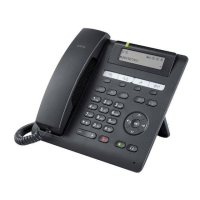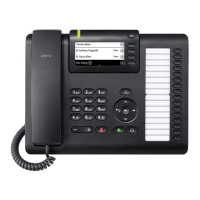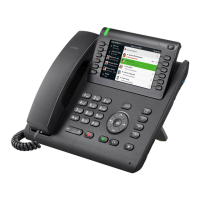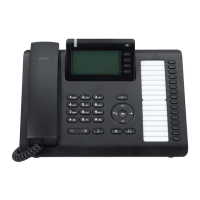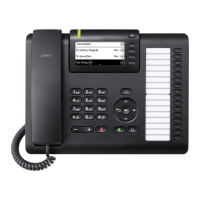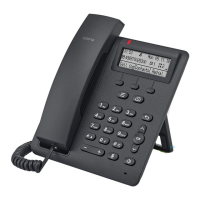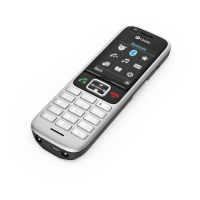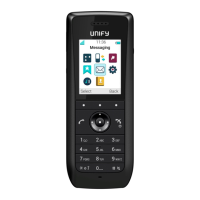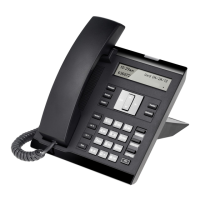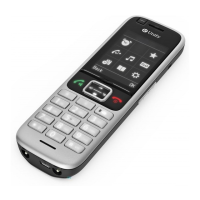Do you have a question about the Unify OpenScape CP205 and is the answer not in the manual?
Product compliance, CE marking, WEEE Directive, and certifications.
Guidelines for phone software updates and essential care and cleaning instructions.
Advice on optimal phone placement and environmental protection considerations.
Introduction to the user guide's structure and explanation of common icons used.
How to interpret phone displays and perform basic setting selections and confirmations.
Defines the phone's purpose, type, and how to optimize speakerphone and display legibility.
Familiarizes users with the physical controls and display of the OpenScape Desk Phone.
Explains the phone's display, idle mode, and how to access the idle menu.
Details function keys, LED indicators, dialpad usage, and navigation controls.
Guides on accessing messages, voicemail, callback requests, and call history logs.
Instructions on accessing the phone's service menu for advanced features and settings.
How to configure display contrast, call volume, and ringer volume for optimal user experience.
Managing second calls, system speed-dial numbers, and programming individual speed dials.
Step-by-step instructions for programming various functions onto the phone's keys.
Exploring enhanced features for dialing keys, including pauses, codes, and pickup key configuration.
Procedures for answering incoming calls via handset, speakerphone, or headset.
How to perform directed call transfers, use speakerphone, and manage call privacy.
Covers off-hook, on-hook, and headset dialing, including en-bloc number entry.
Methods for redialing the last dialed or saved numbers and accessing call logs.
How to search for contacts in corporate and personal phonebooks and initiate calls.
Utilizing speed dialing for quick access and assigning call charges to projects.
Detailed guide on programming and activating various call forwarding types (automatic, delayed, busy, no reply).
Using callback when stations are busy or unanswered, including saving and accepting requests.
Procedures for parking calls manually or automatically and initiating consultation calls.
Comprehensive guide on setting up, adding parties, and managing conference calls.
Explains line keys, primary/secondary lines, private/shared lines, and LED indicators.
How to answer calls in sequence or preferentially using line keys.
Activating/deactivating ringing for calls and forwarding calls on specific lines.
Activating ring transfer for incoming calls and dialing using line keys.
Managing call waiting using a direct station selection (DSS) key for busy lines.
How to hold calls on trunk or line keys and retrieve them, including exclusive hold.
Answering specific held calls and saving numbers for redial on a particular line.
Using the line mailbox to pick up, respond to, and delete messages.
How to identify the active line and make calls on multiple lines alternately.
Entering calls on a line for conference, allowing/blocking parties, and managing privacy.
Blocking unwanted parties from joining calls and setting up third-party monitoring.
Procedures for initiating calls from executive to secretary phones, including camp-on.
How secretaries handle executive calls, including during active calls and transfers.
Transferring calls directly to an executive's phone when the secretary is unavailable.
Managing calls and activating second call features on a secondary executive phone.
Using signal and messenger calls for efficient team communication.
Configuring an alternative answer function for secretary-managed calls.
How to set up and save appointment reminders on the phone for timely alerts.
Logging onto different telephones using PINs and managing call forwarding for mobility.
Procedures for logging off from other phones and reactivating the primary home telephone.
Transferring telephone connection, features, and number to another designated "guest" phone.
Overview of using the system for intercom, announcements, and speaker calls.
Placing one-way speaker calls to internal parties and within groups.
Utilizing two-way intercom for group communication and broadcasting announcements.
Explains One Number Service (ONS) groups for reaching users on multiple phones simultaneously.
Procedures for joining and leaving hunt groups to manage team call distribution.
Managing incoming calls with "Do Not Disturb" and suppressing outgoing caller ID.
Protecting against unwanted speaker calls and securing the phone against unauthorized use.
Checking voice encryption status and identifying anonymous callers via call tracing.
Performing tests to verify the proper functioning of phone keys, display, audio, and other features.
Guidance on responding to error messages and resolving common operational problems.
Information on using an online tool for labeling phone keys with assigned functions or numbers.
Product compliance, CE marking, WEEE Directive, and certifications.
Guidelines for phone software updates and essential care and cleaning instructions.
Advice on optimal phone placement and environmental protection considerations.
Introduction to the user guide's structure and explanation of common icons used.
How to interpret phone displays and perform basic setting selections and confirmations.
Defines the phone's purpose, type, and how to optimize speakerphone and display legibility.
Familiarizes users with the physical controls and display of the OpenScape Desk Phone.
Explains the phone's display, idle mode, and how to access the idle menu.
Details function keys, LED indicators, dialpad usage, and navigation controls.
Guides on accessing messages, voicemail, callback requests, and call history logs.
Instructions on accessing the phone's service menu for advanced features and settings.
How to configure display contrast, call volume, and ringer volume for optimal user experience.
Managing second calls, system speed-dial numbers, and programming individual speed dials.
Step-by-step instructions for programming various functions onto the phone's keys.
Exploring enhanced features for dialing keys, including pauses, codes, and pickup key configuration.
Procedures for answering incoming calls via handset, speakerphone, or headset.
How to perform directed call transfers, use speakerphone, and manage call privacy.
Covers off-hook, on-hook, and headset dialing, including en-bloc number entry.
Methods for redialing the last dialed or saved numbers and accessing call logs.
How to search for contacts in corporate and personal phonebooks and initiate calls.
Utilizing speed dialing for quick access and assigning call charges to projects.
Detailed guide on programming and activating various call forwarding types (automatic, delayed, busy, no reply).
Using callback when stations are busy or unanswered, including saving and accepting requests.
Procedures for parking calls manually or automatically and initiating consultation calls.
Comprehensive guide on setting up, adding parties, and managing conference calls.
Explains line keys, primary/secondary lines, private/shared lines, and LED indicators.
How to answer calls in sequence or preferentially using line keys.
Activating/deactivating ringing for calls and forwarding calls on specific lines.
Activating ring transfer for incoming calls and dialing using line keys.
Managing call waiting using a direct station selection (DSS) key for busy lines.
How to hold calls on trunk or line keys and retrieve them, including exclusive hold.
Answering specific held calls and saving numbers for redial on a particular line.
Using the line mailbox to pick up, respond to, and delete messages.
How to identify the active line and make calls on multiple lines alternately.
Entering calls on a line for conference, allowing/blocking parties, and managing privacy.
Blocking unwanted parties from joining calls and setting up third-party monitoring.
Procedures for initiating calls from executive to secretary phones, including camp-on.
How secretaries handle executive calls, including during active calls and transfers.
Transferring calls directly to an executive's phone when the secretary is unavailable.
Managing calls and activating second call features on a secondary executive phone.
Using signal and messenger calls for efficient team communication.
Configuring an alternative answer function for secretary-managed calls.
How to set up and save appointment reminders on the phone for timely alerts.
Logging onto different telephones using PINs and managing call forwarding for mobility.
Procedures for logging off from other phones and reactivating the primary home telephone.
Transferring telephone connection, features, and number to another designated "guest" phone.
Overview of using the system for intercom, announcements, and speaker calls.
Placing one-way speaker calls to internal parties and within groups.
Utilizing two-way intercom for group communication and broadcasting announcements.
Explains One Number Service (ONS) groups for reaching users on multiple phones simultaneously.
Procedures for joining and leaving hunt groups to manage team call distribution.
Managing incoming calls with "Do Not Disturb" and suppressing outgoing caller ID.
Protecting against unwanted speaker calls and securing the phone against unauthorized use.
Checking voice encryption status and identifying anonymous callers via call tracing.
Performing tests to verify the proper functioning of phone keys, display, audio, and other features.
Guidance on responding to error messages and resolving common operational problems.
Information on using an online tool for labeling phone keys with assigned functions or numbers.
| Resolution | 320 x 240 pixels |
|---|---|
| Connectivity | Ethernet |
| Mounting | Desk or wall mountable |
| Speakerphone | Yes |
| USB Port | No |
| HD Voice | Yes |
| Bluetooth | No |
| Wi-Fi | No |
| Power over Ethernet (PoE) | IEEE 802.3af |
| Protocols | SIP |
| Ethernet Ports | 2 (10/100 Mbps) |
| Supported Codecs | G.711, G.722, G.729 |
